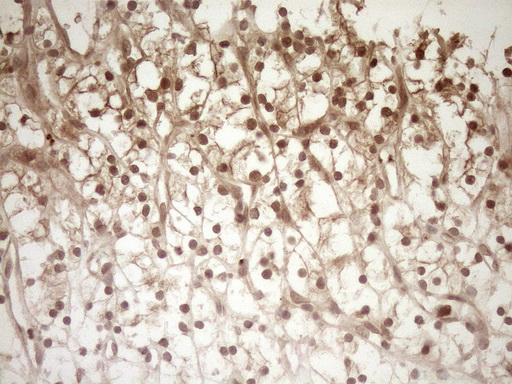HGF Mouse Monoclonal Antibody [Clone ID: OTI1E5]
CAT#: CF807224
Carrier-free (BSA/glycerol-free) HGF mouse monoclonal antibody, clone OTI1E5 (formerly 1E5)
Formulation: Standard
Specifications
| Product Data | |
| Clone Name | OTI1E5 |
| Applications | IHC |
| Recommended Dilution | IHC 1:150 |
| Reactivities | Human, Mouse, Rat |
| Host | Mouse |
| Isotype | IgG1 |
| Clonality | Monoclonal |
| Immunogen | Human recombinant protein fragment corresponding to amino acids 200-494 of human HGF(NP_000592) produced in E.coli. |
| Formulation | Lyophilized powder (original buffer 1X PBS, pH 7.3, 8% trehalose) |
| Reconstitution Method | For reconstitution, we recommend adding 100uL distilled water to a final antibody concentration of about 1 mg/mL. To use this carrier-free antibody for conjugation experiment, we strongly recommend performing another round of desalting process. (OriGene recommends Zeba Spin Desalting Columns, 7KMWCO from Thermo Scientific) |
| Purification | Purified from mouse ascites fluids or tissue culture supernatant by affinity chromatography (protein A/G) |
| Conjugation | Unconjugated |
| Storage | Store at -20°C as received. |
| Stability | Stable for 12 months from date of receipt. |
| Predicted Protein Size | 79.6 kDa |
| Gene Name | hepatocyte growth factor |
| Database Link | |
| Background | Hepatocyte growth factor regulates cell growth, cell motility, and morphogenesis by activating a tyrosine kinase signaling cascade after binding to the proto-oncogenic c-Met receptor. Hepatocyte growth factor is secreted by mesenchymal cells and acts as a multi-functional cytokine on cells of mainly epithelial origin. Its ability to stimulate mitogenesis, cell motility, and matrix invasion gives it a central role in angiogenesis, tumorogenesis, and tissue regeneration. It is secreted as a single inactive polypeptide and is cleaved by serine proteases into a 69-kDa alpha-chain and 34-kDa beta-chain. A disulfide bond between the alpha and beta chains produces the active, heterodimeric molecule. The protein belongs to the plasminogen subfamily of S1 peptidases but has no detectable protease activity. Alternative splicing of this gene produces multiple transcript variants encoding different isoforms. [provided by RefSeq, Jul 2008] |
| Synonyms | DFNB39; F-TCF; HGFB; HPTA; SF |
| Reference Data | |
| Protein Families | Adult stem cells, Druggable Genome, ES Cell Differentiation/IPS, Protease, Transmembrane |
| Protein Pathways | Cytokine-cytokine receptor interaction, Focal adhesion, Melanoma, Pathways in cancer, Renal cell carcinoma |
Documents
| Product Manuals |
| FAQs |
| SDS |
Resources
| Antibody Resources |
Other Versions
| SKU | Description | Size | Price |
|---|---|---|---|
| TA807224 | HGF mouse monoclonal antibody, clone OTI1E5 (formerly 1E5) |
USD 447.00 |
|
| TA807224AM | HGF mouse monoclonal antibody, clone OTI1E5 (formerly 1E5), Biotinylated |
USD 509.00 |
|
| TA807224BM | HGF mouse monoclonal antibody, clone OTI1E5 (formerly 1E5), HRP conjugated |
USD 509.00 |
|
| TA807224S | HGF mouse monoclonal antibody, clone OTI1E5 (formerly 1E5) |
USD 200.00 |
{0} Product Review(s)
Be the first one to submit a review






























































































































































































































































 Germany
Germany
 Japan
Japan
 United Kingdom
United Kingdom
 China
China




